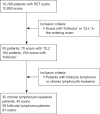Comparison of standardized uptake value and standardized uptake lean body mass metrics in 18F-fluorodeoxyglucose positron emission tomography for assessing transformation in chronic lymphocytic leukemia and follicular lymphoma
- PMID: 40785919
- PMCID: PMC12332721
- DOI: 10.21037/qims-2024-2740
Comparison of standardized uptake value and standardized uptake lean body mass metrics in 18F-fluorodeoxyglucose positron emission tomography for assessing transformation in chronic lymphocytic leukemia and follicular lymphoma
Abstract
Background: The maximum standardized uptake value normalized to body weight (BW) (SUVmax) is a commonly used metric in 18F-fluorodeoxyglucose (FDG) positron emission tomography (PET) imaging for assessing tumor aggressiveness and response to therapy. However, SUVmax is sensitive to changes in BW, potentially leading to inaccuracies in patients with cancer cachexia or obesity. The maximum standardized uptake value normalized to lean body mass (SULmax) has been proposed as a more reliable alternative, particularly in contexts where BW fluctuations are significant. This study aimed to evaluate the relative performance of SUVmax and SULmax in identifying high-grade transformation of chronic lymphocytic leukemia (CLL) and follicular lymphoma (FL) into more aggressive lymphomas.
Methods: We conducted a retrospective, single-center analysis of PET/computed tomography (CT) scans from patients with CLL or FL, measuring the most avid lesion using both SUVmax and SULmax. High-grade transformation was identified through pathological records within 3 months after the scan, and receiver operating characteristic curves were used to compare the diagnostic performance of SUVmax and SULmax.
Results: A total of 32 patients with CLL and 58 with FL were included. Some patients had more than one biopsy, giving a total of 43 samples for CLL and 91 samples for FL. The receiver operating curve analysis showed insufficient evidence (P=0.92) of a statistical difference between SUVmax and SULmax in predicting transformation for CLL, with an area under the curve (AUC) of 0.918 for SUVmax and 0.921 for SULmax. In FL, SULmax also showed similar performance (AUC =0.754) to SUVmax (AUC =0.745) for predicting transformation to diffuse large B-cell lymphoma, with the difference again not significant (P=0.93). When grade 3B FL was also considered to be transformed lymphoma, SUVmax was effectively equal (P=0.96) to SULmax (AUC =0.932 and 0.931, respectively). Optimal cutoffs were about 7 to 8 for both diseases using SUVmax, and 5 for CLL or transformation of FL to a higher-grade lymphoma, but 9 if grade 3B was not counted.
Conclusions: Both SUVmax and SULmax can be reliably used for assessing the transformation of CLL and FL to aggressive lymphomas on 18F-FDG PET/CT. Given SULmax's stability with respect to weight changes, it may be more appropriate for assessing therapeutic response in patients with significant weight fluctuations. Further studies are needed to refine the use of these metrics in clinical practice.
Keywords: Standardized uptake value (SUV); lymphoma; positron emission tomography (PET); quantitation; transformation.
Copyright © 2025 AME Publishing Company. All rights reserved.
Conflict of interest statement
Conflicts of Interest: All authors have completed the ICMJE uniform disclosure form (available at https://qims.amegroups.com/article/view/10.21037/qims-2024-2740/coif). N.S.G. reports grant support from Regeneron and BMS, consulting fees from Genentech, OnoPharma, Janssen, SeaGen, ADC Therapeutics, and KITe, and has participated in a data safety monitoring board or advisory board with BMS, Regeneron, and Novartis. C.E.D. reports consulting fees from ADC, Beigene and Genmab. Royalties from Springer publishing. The other authors have no conflicts of interest to declare.
Figures






Similar articles
-
123I-MIBG scintigraphy and 18F-FDG-PET imaging for diagnosing neuroblastoma.Cochrane Database Syst Rev. 2015 Sep 29;2015(9):CD009263. doi: 10.1002/14651858.CD009263.pub2. Cochrane Database Syst Rev. 2015. PMID: 26417712 Free PMC article.
-
PET-CT for assessing mediastinal lymph node involvement in patients with suspected resectable non-small cell lung cancer.Cochrane Database Syst Rev. 2014 Nov 13;2014(11):CD009519. doi: 10.1002/14651858.CD009519.pub2. Cochrane Database Syst Rev. 2014. PMID: 25393718 Free PMC article.
-
Is 18 F-fluoride PET/CT an Accurate Tool to Diagnose Loosening After Total Joint Arthroplasty?Clin Orthop Relat Res. 2025 Mar 1;483(3):415-428. doi: 10.1097/CORR.0000000000003228. Epub 2024 Sep 11. Clin Orthop Relat Res. 2025. PMID: 39293088
-
Positron emission tomography-adapted therapy for first-line treatment in individuals with Hodgkin lymphoma.Cochrane Database Syst Rev. 2015 Jan 9;1(1):CD010533. doi: 10.1002/14651858.CD010533.pub2. Cochrane Database Syst Rev. 2015. Update in: Cochrane Database Syst Rev. 2025 Mar 26;3:CD010533. doi: 10.1002/14651858.CD010533.pub3. PMID: 25572491 Free PMC article. Updated.
-
PET scan for the detection of histological transformation of follicular lymphoma: A systematic review of diagnostic performance.Blood Rev. 2025 May;71:101270. doi: 10.1016/j.blre.2025.101270. Epub 2025 Jan 28. Blood Rev. 2025. PMID: 39893056
References
LinkOut - more resources
Full Text Sources
